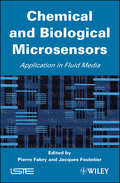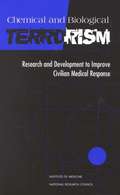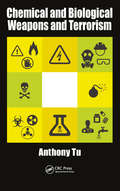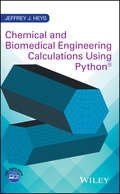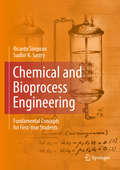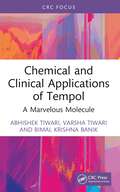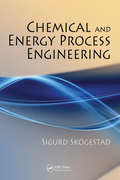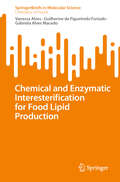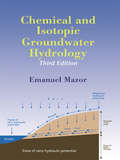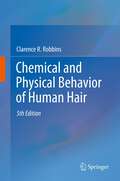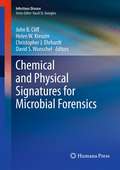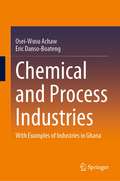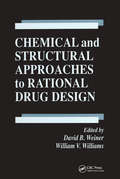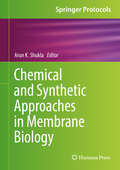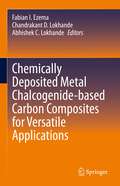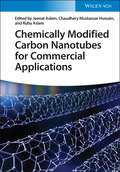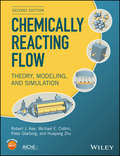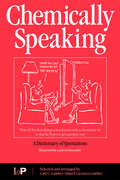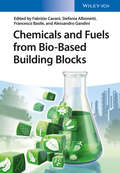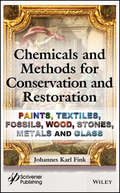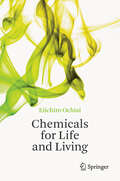- Table View
- List View
Chemical and Biological Microsensors: Applications in Fluid Media (Wiley-iste Ser.)
by Jacques Fouletier Pierre FabryThis book reviews the state of art in the field of chemical sensors for analyses of ionic or molecular species dissolved in liquid media, mainly in aqueous solutions. The transduction of such devices is based on chemical, biological and physical phenomena. The fundamental phenomena involved in these sensors are described in the different chapters by specialists having a good expertise in the field. Numerous recent bibliographic references are given. Most of the devices could be miniaturised using modern technologies allowing a fabrication on a large scale, for a mass production at low cost. Moreover, such devices could open the field of applications in a near future (environmental, biomedical, food industries, domotic and automotive applications etc.).
Chemical and Biological Terrorism: Research and Development to Improve Civilian Medical Response
by National Research CouncilThe threat of domestic terrorism today looms larger than ever. Bombings at the World Trade Center and Oklahoma City's Federal Building, as well as nerve gas attacks in Japan, have made it tragically obvious that American civilians must be ready for terrorist attacks. What do we need to know to help emergency and medical personnel prepare for these attacks? Chemical and Biological Terrorism identifies the R&D efforts needed to implement recommendations in key areas: pre-incident intelligence, detection and identification of chemical and biological agents, protective clothing and equipment, early recognition that a population has been covertly exposed to a pathogen, mass casualty decontamination and triage, use of vaccines and pharmaceuticals, and the psychological effects of terror. Specific objectives for computer software development are also identified. The book addresses the differences between a biological and chemical attack, the distinct challenges to the military and civilian medical communities, and other broader issues. This book will be of critical interest to anyone involved in civilian preparedness for terrorist attack: planners, administrators, responders, medical professionals, public health and emergency personnel, and technology designers and engineers.
Chemical and Biological Weapons and Terrorism
by Anthony TuWritten by the world’s leading expert on the Tokyo sarin attacks, Chemical and Biological Weapons and Terrorism is a comprehensive examination of the use, detection, and prevention of chemical and biological attacks. Divided in two parts, one devoted to chemical and the other biological weapons, this book emphasizes defense, decontamination, detection, treatment, mechanism of toxic action, and pathological effects in the case of each. Covering a diverse range of substances, chapters draw on detailed case studies on the US anthrax attacks, the Tokyo sarin gas attacks, as well as an entire chapter devoted to the Iran-Iraq War co-authored with Dr. Sayid Abbas Foroutan, a former Iranian military surgeon who actively participated in the treatment of Iranian soldiers suffering from gas poisoning. Features include: A case study of the Tokyo sarin gas attacks from the leading expert on the subject A detailed case study on the U.S. anthrax attacks A chapter on the Iran-Iraq War and controversial weapons co-authored with an Iranian military surgeon with first-hand knowledge of the subject Details on the various ways chemical and biological weapons can be constructed and deployed Applicable defense strategies, including detection of materials and decontamination in the event chemical/biological weapons are deployed Featuring over 100 unique photographs and detailed chemical structures, Chemical and Biological Weapons and Terrorism is essential reading for counterterrorism experts, first responders and medical professionals, security consultants and military personnel seeking to expand their knowledge of preventative strategies. The book also will serve as a great resource for students in homeland security, public administration, and criminal justice programs.
Chemical and Biomedical Engineering Calculations Using Python
by Jeffrey J. HeysPresents standard numerical approaches for solving common mathematical problems in engineering using Python. Covers the most common numerical calculations used by engineering students Covers Numerical Differentiation and Integration, Initial Value Problems, Boundary Value Problems, and Partial Differential Equations Focuses on open ended, real world problems that require students to write a short report/memo as part of the solution process Includes an electronic download of the Python codes presented in the book
Chemical and Bioprocess Engineering: Fundamental Concepts for First-Year Students
by Ricardo Simpson Sudhir K. SastryThe goal of this textbook is to provide first-year engineering students with a firm grounding in the fundamentals of chemical and bioprocess engineering. However, instead of being a general overview of the two topics, Fundamentals of Chemical and Bioprocess Engineering will identify and focus on specific areas in which attaining a solid competency is desired. This strategy is the direct result of studies showing that broad-based courses at the freshman level often leave students grappling with a lot of material, which results in a low rate of retention. Specifically, strong emphasis will be placed on the topic of material balances, with the intent that students exiting a course based upon this textbook will be significantly higher on Bloom's Taxonomy (knowledge, comprehension, application, analysis and synthesis, evaluation, creation) relating to material balances. In addition, this book will also provide students with a highly developed ability to analyze problems from the material balances perspective, which will leave them with important skills for the future. The textbook will consist of numerous exercises and their solutions. Problems will be classified by their level of difficulty. Each chapter will have references and selected web pages to vividly illustrate each example. In addition, to engage students and increase their comprehension and rate of retention, many examples will involve real-world situations.
Chemical and Clinical Applications of Tempol: A Marvelous Molecule
by Bimal Krishna Banik Abhishek Tiwari Varsha TiwariA comprehensive and authoritative exploration of Tempol (4-Hydroxy-TEMPO), an exceptional chemical compound with diverse applications in both scientific research and medical practice. This book delves into Tempol's unique properties, mechanisms of action, and its potential role in combating oxidative stress-related disorders. Includes a chapter devoted to the safe handling, storage, and disposal of Tempol in compliance with pharmaceutical regulations. The authors pay particular attention to pharmaceutical regulations in the industry.
Chemical and Energy Process Engineering
by Sigurd SkogestadEmphasizing basic mass and energy balance principles, Chemical and Energy Process Engineering prepares the next generation of process engineers through an exemplary survey of energy process engineering, basic thermodynamics, and the analysis of energy efficiency. By emphasizing the laws of thermodynamics and the law of mass/matter conservation, the
Chemical and Enzymatic Interesterification for Food Lipid Production (SpringerBriefs in Molecular Science)
by Vanessa Alves Guilherme de Furtado Gabriela Alves MacedoThis book addresses special lipids produced by chemical and enzymatic interesterification and explores the interesterification process and its crucial role in the modification of oils for various applications. The book discusses the chemical and enzymatic aspects of this process, providing an in-depth understanding of its mechanism, benefits, and limitations. The book covers key concepts such as the mechanism of interesterification, the use of immobilized lipases in enzymatic interesterification, and current applications of interesterification in fats and oils. Particular attention is given to acidolysis, alcoholysis, glycerolysis, and transesterification - the four types of interesterification reactions, and to the advantages and drawbacks of both enzymatic and chemical interesterification. In this book, the authors address critical questions like the fate of fatty acids from interesterified lipids after consumption and their long-term health effects. Readers will also learn more about the current applications of interesterification in fats and oils, including special lipids like plastic fats, human milk fat substitutes, structured lipids enriched with essential fatty acids, cocoa butter equivalents and substitutes, and low-calorie structured lipids. Aimed at researchers and professionals in food science, this book offers valuable insights into the production of various specialty fats through enzymatic interesterification, thereby equipping readers with the knowledge to innovate in the field of food applications. Readers with a background in food chemistry will benefit from its detailed explanation of lipase-catalyzed synthesis and the use of alkali metals in interesterification.
Chemical and Isotopic Groundwater Hydrology (Books In Soils, Plants, And The Environment Ser. #Vol. 98)
by Emanuel MazorThis updated and expanded edition provides a thorough understanding of the measurable properties of groundwater systems and the knowledge to apply hydrochemical, geological, isotopic, and dating approaches to their work. This volume includes question and answer discussions for key concepts presented in the text and the basic hydrological, geological, and physical parameters to be observed and measured. Chemical and Isotopic Groundwater Hydrology, Third Edition covers the chemical tools of groundwater hydrology, the isotopic composition of water and groundwater dating by tritum, carbon-14, Cl-36, and He-4, as well as the application of fossil groundwater as a paleoclimatic indicator.
Chemical and Petroleum Industries at Newtown Creek: History and Technology (SpringerBriefs in Molecular Science)
by Peter SpellaneThis book constructs a history of Newtown Creek’s industrial expansion during the period that began in the 1840s and continued through the early years of the 20th century. In that period, the production of reagent chemicals and refined materials near the center of modern-day New York City grew steadily, as practitioners, alert to European advances in chemical science, developed and applied increasingly sophisticated technologies. Innovations in methods of production, ready access to domestic and international markets, and sustained growth in volumes of production at Newtown Creek in the late 19th century had profound consequences for the practice of industrial chemistry in the United States and for the economic vitality of the City of New York. Industrial practice progressed from the recovery of animal tissues to the refining of crude petroleum and the production of high-purity copper and other metals from mineral ores. With attention to each company’s technical expertise and principal products, this book examines the interdependence of the chemicals- and materials-producing industries that thrived along Newtown Creek’s shores. The author recounts Newtown Creek’s industrial history alongside the stories of well-known New Yorkers – Peter Cooper, Charles Pratt, John D. and William Rockefeller – and other less celebrated or less notorious characters. This book provides a valuable account of New York’s history in the manufacture of reagent chemicals and refined fuels and metals and will appeal to researchers, scholars and historians interested in the early years of industrial chemistry.
Chemical and Physical Behavior of Human Hair
by Clarence R. RobbinsHuman hair is the subject of a remarkably wide range of scientific investigations. Its chemical and physical properties are of importance to the cosmetics industry, forensic scientists and to biomedical researchers. The fifth edition of this book confirms its position as the definitive monograph on the subject. Previous editions were recognized as "concise and thorough" (Journal of the American Chemical Society), "an invaluable resource" (Canadian Forensic Science Society Journal), and "highly recommended" (Textile Research Journal). Chemical and Physical Behavior of Human Hair is a teaching guide and reference volume for cosmetic chemists and other scientists in the hair products industry, academic researchers studying hair and hair growth, textile scientists and forensic specialists. Features of the Fifth Edition: Recent advances in the classification and characterization of the different proteins and genes in IF and keratin associated proteins in human hair are described. The mechanism and incidence of hair growth and loss and hair density vs. age of males & females are described for Asians, Caucasians and Africans in different scalp regions. Details of hair surface lipids and cuticle membranes provide a better understanding of the surface and organization of the CMC and its involvement in stress strain is presented. Recent evidence demonstrates a more bilateral structure in curly hair and a more concentric arrangement of different cortical proteins in straighter hair. SNPs involved in hair form (curl and coarseness) and pigmentation and genes in alopecia and hair abnormalities are described. The latest biosynthetic scheme for hair pigments and structures for these and the different response of red versus brown-black pigments to photodegradation is described.A new method for curvature on 2,400 persons from different countries and groups is used to assign curvature throughout this book. Additional data for age and effects on diameter, ellipticity, elastic modulus, break stress and other parameters are presented with much larger data sets featuring statistical analyses. Hair conditioning, strength, breakage, split ends, flyaway, shine, combing ease, body, style retention, manageability and feel parameters are defined and described. A new section of different life stages by age groups considering collective and individual changes in hair fiber properties with age and how these affect assembly properties.
Chemical and Physical Signatures for Microbial Forensics (Infectious Disease)
by Helen W. Kreuzer David S. Wunschel John B. Cliff Christopher J. EhrhardtCombining the disciplines of biological, physical and chemical science, microbial forensics has a rapidly rising profile in a world increasingly troubled by the threat of 'biocrime' and 'bioterrorism'. This valuable resource is a major addition to a body of literature reckoned to lack sufficient breadth. It presents a variety of phenotypic and trace signature methodologies associated with cultured microorganisms that, despite being genetically identical, may be characterized by differing cultural environments. One of the central challenges faced by those working in this field is the sheer diversity of potentially harmful agents, which in themselves total more than 1000 viruses, bacteria, fungi and protozoan parasites. Their numerous additional variants render the process of 'fingerprinting' biological agents notoriously difficult, especially when the limitations of genetic analysis are factored in. Attribution of crime is relatively easy through human DNA, but lacking the genetic individuation of humans and animals, microbial forensics has to complement phylogenetic techniques with chemical and physical ones. In the best case, genetic analysis in the 'biocrime' sector can exclude sources, narrow the population of possible sources and support associations with potential sources. To complement these genetic techniques, chemical and physical methods can be used to compare 'signatures' imparted to microbial samples by environments in which they are grown and processed. Collating a range of microbiological fingerprinting techniques in one volume, and covering everything from statistical analysis to laboratory protocols, this publication furthers the aim of forensic investigators who need robust and legally admissible forensic evidence to present in a courtroom.
Chemical and Process Industries: With Examples of Industries in Ghana
by Osei-Wusu Achaw Eric Danso-BoatengThis textbook presents a thorough overview of chemical and process industries. It describes the standard technologies and the state of the industries and the manufacturing processes of specific chemical and allied products. It includes examples of industries in Ghana, highlighting the real-world applications of these technologies.The book introduces new developments in the processes in chemical industry, focuses on the technology and methodology of the processes and the chemistry underlying them. It offers guidance on operating of processing units. Furthermore, it includes sections on safety and environmental pollution control in industry.With a pedagogical and comprehensive approach, utilizing illustrations and tables, this book provides students in chemical engineering and industrial chemistry with a concise and up-to-date overview of this diverse subject.
Chemical and Structural Approaches to Rational Drug Design (Handbooks In Pharmacology And Toxicology Ser. #14)
by David B. Weiner; William B. WilliamsThis book is the first to provide both a broad overview of the current methodologies being applied to drug design and in-depth analyses of progress in specific fields. It details state-of-the-art approaches to pharmaceutical development currently used by some of the world's foremost laboratories. The book features contributors from a variety of fields, new techniques, previously unpublished data, and extensive reference lists.
Chemical and Synthetic Approaches in Membrane Biology (Springer Protocols Handbooks)
by Arun K. ShuklaThis practical volume brings together a broad range of topics related to membrane biology research with particular emphasis on novel approaches, technology platforms, and emerging tools in this area of study. Beginning with chapters pertaining to artificial or designer membrane mimetics that can be utilized for in vitro studies of membrane-lipid interactions, it then continues by covering the approaches and methodologies to directly investigate membrane protein structure, localization, and dynamics. Written for the Springer Protocols Handbooks series, this collection focuses on in-depth, hands-on protocols from experts in the field. Authoritative and cutting-edge, Chemical and Synthetic Approaches in Membrane Biology serves as an ideal guide to researchers investigating the vital properties of cellular membranes.
Chemical kinetics
by E. Yu KharitonovaThe volume is devoted to the problem of chemical kinetics on modern level. The book includes information on chemical physics of nanocomposites, degradation, stabilization and flammability of polymeric materials as well as free radical mechanism of oxidation of organic compounds, thermostability, mechanism of action of catalytical systems and inhibi
Chemically Active
by Vicki CobbFun scientific experiments that can be practiced in your home kitchen with simple materials available at your local drug & hardware stores.
Chemically Deposited Metal Chalcogenide-based Carbon Composites for Versatile Applications
by Fabian I. Ezema Chandrakant D. Lokhande Abhishek C. LokhandeThis book satisfies the interest and curiosity of beginners in thin film electrode preparations, characterizations, and device making, while providing insight into the area for experts. The considerable literature on ‘metal chalcogenides based carbon composites and their versatile applications’ reflect its importance for research and demonstrate how it’s now reached a level where the timely review is necessary to understand the current progress and recent trends and future opportunities. In the book, the authors examine recent advances in the state-of-the-art fabrication techniques of metal sulfide based carbon composites along with their working mechanisms, associated issues/solutions, and possible future are discussed. In addition, detailed insight into the properties and various applications including principles, design, fabrication, and engineering aspects are further discussed.
Chemically Imbalanced: Everyday Suffering, Medication, and Our Troubled Quest for Self-Mastery
by Joseph E. DavisA study of how ordinary people deal with everyday problems through self-mastery and mental health care practices.Everyday suffering—those conditions or feelings brought on by trying circumstances that arise in everyone’s lives—is something that humans have grappled with for millennia. But the last decades have seen a drastic change in the way we approach it. In the past, a person going through a time of difficulty might keep a journal or see a therapist, but now the psychological has been replaced by the biological: instead of treating the heart, soul, and mind, we take a pill to treat the brain.Chemically Imbalanced is a field report on how ordinary people dealing with common problems explain their suffering, how they’re increasingly turning to the thin and mechanistic language of the “body/brain,” and what these encounters might tell us. Drawing on interviews with people dealing with struggles such as underperformance in school or work, grief after the end of a relationship, or disappointment with how their life is unfolding, Joseph E. Davis reveals the profound revolution in consciousness that is underway. We now see suffering as an imbalance in the brain that needs to be fixed, usually through chemical means. This has rippled into our social and cultural conversations, and it has affected how we, as a society, imagine ourselves and envision what constitutes a good life. Davis warns that what we envision as a neurological revolution, in which suffering is a mechanistic problem, has troubling and entrapping consequences. And he makes the case that by turning away from an interpretive, meaning-making view of ourselves, we thwart our chances to enrich our souls and learn important truths about ourselves and the social conditions under which we live.Praise for Chemically Imbalanced“Chemically Imbalanced is an excellent addition to the works in social sciences and humanities that examine the distress of ordinary Americans from the second half of the twentieth century onward, a period when commercialized pills and the psychology-based notion of self-improvement entered the minds of Americans.” —Metascience“Chemically Imbalanced raises important questions, offers new insight into the power and reach of the biomedical model and neurobiological thinking, and I highly recommend it. I encourage readers to assign it, especially in graduate-level mental health and illness classes—or any class looking for a discussion on people’s experiences with suffering and the broad impacts of biomedical thinking and treatment.” —Social Forces
Chemically Modified Carbon Nanotubes for Commercial Applications
by Chaudhery Mustansar Hussain Jeenat Aslam Ruby AslamChemically Modified Carbon Nanotubes for Commercial Applications Discover the go-to handbook for developers and application-oriented researchers who use carbon nanotubes in real products Carbon nanotubes have held much interest for researchers since their discovery in 1991. Due to their low mass density, large aspect ratio, and unique physical, chemical, and electronic properties, they provide a fertile ground for innovation in nanoscale applications. The development of chemical modifications that can enhance the poor dispersion of carbon nanotubes in solvents and improve interactions with other materials have enabled extensive industrial applications in a variety of fields. As the chemistry of carbon nanotubes and their functionalization becomes better understood, Chemically Modified Carbon Nanotubes for Commercial Applications presents the most recent developments of chemically modified carbon nanotubes and emphasizes the broad appeal for commercial purposes along many avenues of interest. The book reviews their already realized and prospective applications in fields such as electronics, photonics, separation science, food packaging, environmental monitoring and protecting, sensing technology, and biomedicine. By focusing on their commercialization prospects, this resource offers a unique approach to a significant and cutting-edge discipline. In Chemically Modified Carbon Nanotubes for Commercial Applications readers will also find: Case studies that emphasize the information presented in each chapter Each chapter includes important websites and suggested reading materials Discussion of current applications of the relevant methodologies in every chapter A look at future perspectives in each application area to highlight the scope for next steps within the industry Chemically Modified Carbon Nanotubes for Commercial Applications is a valuable reference for material scientists, chemists (especially those focused on environmental concerns), and chemical and materials engineering scientists working in R&D and academia who want to learn more about chemically modified carbon nanotubes for various scalable commercial applications. It is also a useful resource for a broad audience: anyone interested in the fields of nanomaterials, nanoadsorbents, nanomedicine, bioinspired nanomaterials, nanotechnology, nanodevices, nanocomposites, biomedical application of nanomaterials, nano-engineering, and high energy applications.
Chemically Reacting Flow: Theory, Modeling, and Simulation
by Robert J. Kee Michael E. Coltrin Peter Glarborg Huayang ZhuA guide to the theoretical underpinnings and practical applications of chemically reacting flow Chemically Reacting Flow: Theory, Modeling, and Simulation, Second Edition combines fundamental concepts in fluid mechanics and physical chemistry while helping students and professionals to develop the analytical and simulation skills needed to solve real-world engineering problems. The authors clearly explain the theoretical and computational building blocks enabling readers to extend the approaches described to related or entirely new applications. New to this Second Edition are substantially revised and reorganized coverage of topics treated in the first edition. New material in the book includes two important areas of active research: reactive porous-media flows and electrochemical kinetics. These topics create bridges between traditional fluid-flow simulation approaches and transport within porous-media electrochemical systems. The first half of the book is devoted to multicomponent fluid-mechanical fundamentals. In the second half the authors provide the necessary fundamental background needed to couple reaction chemistry into complex reacting-flow models. Coverage of such topics is presented in self-contained chapters, allowing a great deal of flexibility in course curriculum design. • Features new chapters on reactive porous-media flow, electrochemistry, chemical thermodynamics, transport properties, and solving differential equations in MATLAB • Provides the theoretical underpinnings and practical applications of chemically reacting flow • Emphasizes fundamentals, allowing the analyst to understand fundamental theory underlying reacting-flow simulations • Helps readers to acquire greater facility in the derivation and solution of conservation equations in new or unusual circumstances • Reorganized to facilitate use as a class text and now including a solutions manual for academic adopters Computer simulation of reactive systems is highly efficient and cost-effective in the development, enhancement, and optimization of chemical processes. Chemically Reacting Flow: Theory, Modeling, and Simulation, Second Edition helps prepare graduate students in mechanical or chemical engineering, as well as research professionals in those fields take utmost advantage of that powerful capability.
Chemically Speaking: A Dictionary of Quotations
by Carl C. Gaither Alma E. Cavazos-GaitherIn these days of ever-increasing specialization, it is important to gain a broad appreciation of scientific disciplines such as chemistry. With this in mind, Chemically Speaking: A Dictionary of Quotations contains the words and wisdom of several hundred scientists, writers, philosophers, poets, and academics. Some quotations are illustrated by amu
Chemicals and Fuels from Bio-Based Building Blocks
by Francesco Basile Stefania Albonetti Alessandro Gandini Fabrizio CavaniAn up-to-date and two volume overview of recent developments in the field of chemocatalytic and enzymatic processes for the transformation of renewable material into essential chemicals and fuels. Experts from both academia and industry discuss catalytic processes currently under development as well as those already in commercial use for the production of bio-fuels and bio-based commodity chemicals. As such, they cover drop-in commodity chemicals and fuels, as well as bio-based monomers and polymers, such as acrylic acid, glycols, polyesters and polyolefins. In addition, they also describe reactions applied to waste and biomass valorization and integrated biorefining strategies. With its comprehensive coverage of the topic, this is an indispensable reference for chemists working in the field of catalysis, industrial chemistry, sustainable chemistry, and polymer synthesis.
Chemicals and Methods for Conservation and Restoration: Paintings, Textiles, Fossils, Wood, Stones, Metals, and Glass
by Johannes Karl FinkBefore the 1970s, most information concerning the conservation and restoration of paintings, wood, and archaeological artefacts were focused on the history of the artefacts, previous attempts of conservation, and the future use of these artefacts. The technical methods of how the restoration and conservation were made were dealt with only very briefly. Today, sophisticated methods of scientific analysis such as DNA are common place, and this encourages conservators and scientists to work together to work out the development of new methods for analysis and conservation of artefacts. This book focuses on the chemicals used for conservation and restoration of various artefacts in artwork and archaeology, as well as special applications of these materials. Also the methods used, both methods for cleaning, conservation and restoration, as well as methods for the analysis of the state of the respective artefacts. Topics include oil paintings, paper conservation, textiles and dyes for them, archaeological wood, fossils, stones, metals and metallic coins, and glasses, including church windows.
Chemicals for Life and Living
by Eiichiro OchiaiChemicals often have a negative Image among the general public. But there is no material world or indeed human beings without chemicals. The material world is operated by chemicals. The title 'Chemicals for Life and Living' implies that the material world is staged and played by chemicals. The book consists of five parts and an appendix. Part 1 - Essentials for life; Part 2 - Enhancing health; Part 3 - For the fun of life; Part 4 - Chemistry of the universe and earth, and Part 5 - Some negative effects of chemicals. The appendix gives a brief summary of what chemistry is all about, including a short chapter of chemical principles. No quantitative calculations are included in this book so that it is appealing for everyone - not just chemists.
